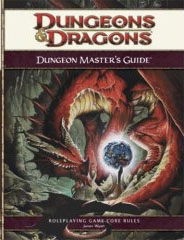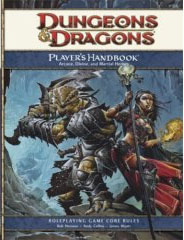 Running low-level combat encounters in 4th Edition is considerably more complicated than in previous edtiions. I would roughly estimate the level of complexity as being equivalent to a difficult 15th level encounter in 3rd Edition.
Running low-level combat encounters in 4th Edition is considerably more complicated than in previous edtiions. I would roughly estimate the level of complexity as being equivalent to a difficult 15th level encounter in 3rd Edition.
In my experience, there are three factors which determine how complicated an encounter is to run: The number of abilities the monsters have, keeping track of hit points, and making stat-block adjustments as a result of buff and buff-like effects.
MONSTER ABILITIES: In 3rd Edition, high-level creatures frequently featured many different abilities. Part of the complexity of running encounters was knowing what these abilities were and how they could be used to best effect. Part of mastering the system meant learning how to quickly discriminate between the abilities which were combat-relevant and which weren’t, and revised stat blocks helped make that distinction clearer.
In 4th Edition, the designers intentionally stripped monsters of their non-combat abilities and worked to reduce the number of combat-relevant abilities, as well. Their theory, as expressed by David Noonan, was simple: “We wanted our presentation of monsters to reflect how they’re actually used in D&D gameplay. A typical monster has a lifespan of five rounds. That means it basically does five things, ever, period, the end.”
Their logic was fundamentally flawed when it came to 3rd Edition, for reasons which I’ll only briefly summarize here: First, it ignores the fact that you’ll frequently meet the same type of monster more than once (in which case having some variety in what the monster can do is valuable). Second, it ignores the fact that monsters need to be able to react to the unexpected actions of the PCs (in which case having a wider array of tactical options is valuable). Finally, and most importantly, it neglects to consider that D&D is supposed to be a roleplaying game, not a tactical miniatures game. In a roleplaying game, even if you’re fighting, the reasons why you’re fighting are frequently important.
(As I’ve written before: “It’s often the abilities that a creature has outside of combat which create the scenario. And not just the scenario which leads to combat with that particular creature, but scenarios which can lead to many different and interesting combats. Noonan, for example, dismisses the importance of detect thoughts allowing a demon to magically penetrate the minds of its minions. But it’s that very ability which may explain why the demon has all of these minions for the PCs to fight; which explains why the demon is able to blackmail the city councillor that the PCs are trying to help; and which allows the demon to turn the PCs’ closest friend into a traitor.”)
All of these flaws in WotC’s reasoning remain equally valid when it comes to 4th Edition, but we can also add another one to he batch: Due to the “padded sumo wrestling” nature of the system, monsters in 4th Edition tend to have lifespans much longer than 5 rounds. Since their tactical options have been limited, 4th Edition monsters tend to do the same couple of things over and over again — they don’t have any other choice, after all. This is not only the result of the “padded sumo wrestling” combat, but also contributes to it by making the longer combats boring.
These problems with WotC’s design ethos, however, are relatively tangential to the issue at hand: Reducing the complexity of running combat. Reducing the number of abilties a monster has would, in fact, accomplish that… if the number of monsters in each encounter were the same.
But they aren’t. Not only is 4th Edition designed to have more monsters in a single encounter, but the system is specifically designed with the expectation that you will have a greater variety of monsters in each encounter. In 3rd Edition you might have a battle with 8 ogres, but they’d all have the same abilities. In 4th Edition you might have a battle with 8 ogres, but they’ll have five different stat blocks.
For example, demons and devils are generally agreed to be the most complicated 3rd Edition monsters to use in an encounter. A horned devil in 3rd Edition is a CR 15 encounter. They have roughly 14 abilities that could be used during combat (if you count both their different attacks and non-combat abilities which are relatively easy to ignore; in practice the effective number of abilities you need to keep track of is considerably lower).
Encounter A3 in Keep on the Shadowfell features 5 different types of kobolds who have, between them, 12 different abilities that could be used during combat. (And that’s not counting their different attacks, which — in an apples-to-apples comparison — would increase the number of abilities to 18.)
Making things even more difficult is that many abilities in 4th Edition are immediate actions: They take place during other characters’ turns. In 3rd Edition most creature abilities can only be used on the combatant’s own turn — which means that simply taking a few moments to look over a monster’s stat block on their turn was generally effective. But in 4th Edition it’s not enough to simply be able to quickly parse a stat block, you pretty much have to keep a large number of abilities in your head at all times so that your monster’s can take advantage of the triggers for their actions as they occur.
TRACKING HIT POINTS: One effect of the minion rules is to eliminate the number of monsters the DM needs to track hit points for (since any hit kills a minion). This is fine as far as it goes, but — once again — 4th Edition encounters are generally designed around larger groups of monsters. Which means, in practice, it appears that you’ll have just as many hit point totals to keep track of.
For example, looking at the first few encounters in Keep on the Shadowfell we find in the first encounter three creatures; in A1 five creatures; in A2 three creatures; in A3 seven creatures; and in A4 four creatures that need to have hit point totals tracked.
BUFFS: One of the things I hear people claiming is that there aren’t as many buffs in 4th Edition. This is not actually true. It’s true that there are fewer “permanent” buffs (in the form of equipment giving flat bonuses, for example) and it’s also true that there are fewer buffs to ability scores and the like.
But short-term bonuses and penalties? They’re all over the damn place. And, to make matters worse, they’re largely situational bonuses — by which I mean that you get things like a +1 for each ally adjacent to your target; -2 for being marked; +1 to a particular skill check if you’re within 5 squares of one character; -2 to a different skill check if you’re within 6 squares of another one. Marks just add to the laundry list of such abilities.
These situational buffs are the worst type of buff when it comes to adding complexity to battle. Permanent buffs from equipment, for example, are calculated into a stat block at character creation. And for oft-used buffs (like a barbarian’s rage or always casting bull’s strength on the fighter before a big battle), there are tricks and work-arounds (like prepping a second character sheet or stat block).
But for situational buffs you pretty much have to keep on your toes. You have to both (a) remember that the situational buff exists and (b) make frequent on-the-fly adjustments to multiple stat blocks as the buffs come and go (or move around).
THE BOTTOM LINE: I was always fairly comfortable with the level of complexity you’d find in high-level 3rd Edition encounters. It took a certain degree of system mastery, certainly, but it’s a level of system mastery that flowed pretty naturally into my blood the first time I ran a group from 1st to 20th.
So, for the most part, 4th Edition combat looks just fine to me. But if you’re someone who disliked the complexity of high level 3rd Edition encounters, you should be warned that this is par for the course in 4th Edition.
I’ll also say that I have little confidence that I would ever get to a point where I would be able to run 4th Edition encounters flawlessly. The multitude of situational buffs and marks are something that I’m likely to get more right than wrong, but I suspect there’ll always be something getting overlooked at some point during a session.
THE GOOD NEWS: I can’t vouch for this through playtesting, but it looks like this level of complexity stays pretty constant from 1st level to 30th level in 4th Edition. Like many things in the system, if they’ve hit your sweet spot then you’re going to be fairly happy for the duration. But if they’ve missed your sweet spot — or if you had many different sweet spots (and liked the variety of having different styles of gameplay) — then 4th Edition is going to be continuously problematic.












